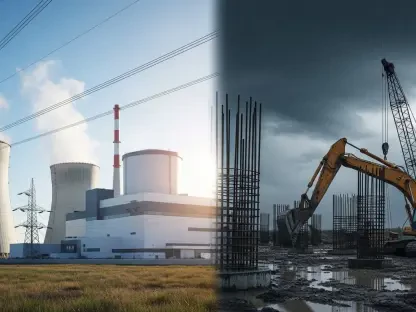Imagine a region of six states, home to millions, relying on a single entity to keep the lights on while facing the unrelenting pressure of a warming planet, a challenge that grows more urgent every day. This is the reality for New England, where ISO New England (ISO-NE), the regional grid operator, holds the reins of an intricate power system. Tasked with ensuring reliability and balancing energy demands, ISO-NE stands at a critical crossroads as the climate crisis demands a rapid pivot to renewable energy. With a recent leadership change shaking up its long-standing structure, the question looms: can this organization shed its opaque past and steer toward a sustainable future?
Understanding ISO-NE’s Role and Legacy
ISO-NE, established in 1997, serves as the backbone of New England’s electric grid, managing the flow of power across Connecticut, Maine, Massachusetts, New Hampshire, Rhode Island, and Vermont. Its primary mission is to maintain grid reliability, oversee wholesale electricity markets, and plan for the region’s energy needs. Yet, for much of its history, this vital organization operated in the shadows, with little public attention or accountability, allowing decisions to unfold behind closed doors.
This lack of oversight has shaped a legacy that often favored traditional energy sources over innovative, cleaner alternatives. As the entity responsible for integrating new technologies into the grid, ISO-NE’s slow adaptation has drawn scrutiny, especially as the urgency of decarbonization grows. Understanding this background is essential to grasp why stakeholders are now pushing for sweeping changes in how the organization functions.
The historical context also reveals a disconnect between ISO-NE’s operations and the public it serves. While it managed complex systems with technical expertise, the absence of meaningful engagement with communities left many unaware of its influence on their daily lives. This gap has fueled a growing demand for transparency as New England’s clean energy goals become non-negotiable.
Milestones and Critiques of Performance
Over the decades, ISO-NE has navigated a challenging landscape, often prioritizing fossil fuel interests in its market designs and planning processes. This approach delayed the integration of renewable sources like wind and solar, even as neighboring regions began accelerating their transitions. Specific data points, such as a dismal “F” grade in a national governance scorecard for accessibility and accountability, underscore the depth of these systemic issues.
Beyond rankings, public engagement has remained minimal, with limited forums for residents to voice concerns or contribute ideas. This has perpetuated a cycle where decisions impacting energy costs and environmental health are made without adequate input from those most affected. Such critiques highlight a persistent barrier to aligning the grid operator’s policies with the region’s ambitious climate targets.
Despite these challenges, there have been moments of progress worth noting. Small but significant shifts, like opening one annual board meeting to the public, signal an acknowledgment of the need for greater visibility. However, these steps are often seen as insufficient when measured against the scale of reform needed to address pressing energy demands.
Incremental Progress Under Past Leadership
During Gordon van Welie’s 25-year tenure as CEO, ISO-NE took tentative steps toward openness. The transformation of the Consumer Liaison Group (CLG) into a platform prioritizing residential consumers over industrial players marked a shift in focus, aiming to amplify everyday voices in energy discussions. This change offered a glimpse of potential for broader inclusion.
Additionally, efforts such as hiring a policy advisor for community and environmental affairs showed an intent to bridge gaps with stakeholders. Translating key materials into Spanish and adopting a vision statement embracing clean energy further reflected a slow pivot. Yet, these measures, while positive, often felt like surface-level adjustments rather than deep structural reforms.
Persistent Shortcomings
Despite these efforts, significant hurdles remain in ISO-NE’s governance model. Transparency continues to be a sticking point, with most board meetings and critical deliberations still inaccessible to the public. This opacity fosters distrust among communities eager to understand how decisions shape their energy future.
Accessibility also lags, as opportunities for meaningful input are scarce for those outside industry circles. The lack of structured feedback mechanisms on environmental initiatives compounds the issue, leaving clean energy advocates frustrated. These persistent gaps hinder alignment with regional objectives to slash carbon emissions.
Moreover, accountability mechanisms are weak, often leaving state policies and public priorities sidelined. Without robust systems to ensure ISO-NE answers to the broader needs of New England, the risk of perpetuating outdated practices looms large. Addressing these flaws remains a pressing concern for all stakeholders involved.
Unique Position in the Energy Landscape
ISO-NE occupies a distinctive spot among regional grid operators, facing intense scrutiny from both public and governmental bodies at a time when the energy sector is undergoing rapid transformation. Unlike some counterparts, its jurisdiction spans a region with aggressive clean energy mandates, amplifying the stakes of its governance practices. This dynamic positions it as a potential trailblazer—or a cautionary tale—in grid modernization.
The organization’s ability to adapt could set a precedent for others across the nation, where grid operators are increasingly under the microscope. With electricity demand projected to soar in coming years, ISO-NE’s response to calls for reform might influence how decentralized and renewable-heavy grids are managed elsewhere. Its unique challenges thus carry national implications.
What further sets ISO-NE apart is the vocal advocacy from New England’s state leaders and communities. This regional pressure, unmatched in intensity in some other areas, creates a fertile ground for testing new governance models. If successful, the operator could redefine how public participation and clean energy integration are balanced in complex systems.
Current State and Recent Developments
Today, ISO-NE finds itself at a pivotal moment with the transition to new leadership under Dr. Vamsi Chadalavada, who stepped into the CEO role following van Welie’s long tenure. This shift is widely seen as an opportunity to break from entrenched practices and embrace a more inclusive approach. The timing aligns with heightened calls for reform, making the stakes even higher.
Recent developments have added momentum to this push for change. State senators, governors, and the New England States Committee on Electricity (NESCOE) have intensified their advocacy, issuing letters and reports urging greater collaboration and openness. These efforts reflect a collective determination to see ISO-NE evolve into a partner in achieving decarbonization goals.
Additionally, stakeholder engagement is gaining traction, with discussions at high-level meetings emphasizing the need for public involvement in grid planning. From 2025 onward, there is potential for initiatives like expanded CLG roles and open board sessions to take shape. These steps, if implemented, could mark a significant departure from past limitations, setting a new tone for the organization’s direction.
Reflection and Broader Impacts
ISO-NE’s journey offers a lens into the complexities of transitioning a critical infrastructure entity amid a global climate emergency. Its incremental improvements, such as enhanced consumer representation, stand as strengths, yet they are overshadowed by historical opacity and governance failures. Balancing these realities is key to understanding its current trajectory.
The organization’s influence extends beyond New England, potentially shaping how grid operators nationwide approach transparency and accountability. If ISO-NE can overhaul its practices, it might inspire similar reforms elsewhere, contributing to a more responsive energy sector. This ripple effect underscores the importance of its next moves.
Reflection
Examining ISO-NE’s track record reveals a mixed picture of cautious progress against a backdrop of significant challenges. While steps like public access to a single board meeting annually show intent, they pale in comparison to the deep-rooted issues of limited stakeholder input. This duality defines much of its public perception today.
Another angle to consider is the technical expertise ISO-NE brings to grid management, a strength often underappreciated amid governance critiques. Yet, without coupling this proficiency with open dialogue, the risk of misalignment with community needs persists. Bridging this divide remains a central task for its leadership.
Broader Impact
Looking outward, ISO-NE’s potential transformation could redefine industry standards for integrating clean energy into aging grids. Success in this arena might encourage other operators to adopt participatory models, fostering a culture of collaboration over isolation. Such a shift would be a win for national decarbonization efforts.
Furthermore, the societal implications are profound, as a more accountable ISO-NE could empower communities to play active roles in energy decisions. This democratization of the grid aligns with broader trends toward decentralization, where consumers also contribute as producers. The outcome of this experiment in governance could resonate for generations.
Moving Forward: The Path Ahead
Reflecting on ISO-NE’s past has shown a struggle to balance reliability with the pressing need for clean energy, marked by slow progress and significant governance gaps. The leadership transition to Dr. Vamsi Chadalavada has opened a window for meaningful change, spotlighting an urgent demand for transparency and public engagement. Historical challenges, from poor scorecard rankings to limited accessibility, have underscored the scale of reform needed.
Looking back, the growing advocacy from state leaders and communities has built a foundation for optimism, pushing ISO-NE to rethink its role. As a next step, embracing immediate actions like opening all board meetings and enhancing community feedback channels has appeared as feasible starting points. These efforts, paired with long-term structural alignment with regional policies, have promised to reshape the organization’s impact.
Ultimately, the path forward hinges on sustained pressure from stakeholders and a willingness within ISO-NE to innovate. Exploring models of collaboration, perhaps by learning from other grid operators who have navigated similar transitions, has offered a blueprint for success. Championing these reforms stands as a vital endeavor to ensure New England’s energy future aligns with the imperatives of a cleaner, more equitable world.









